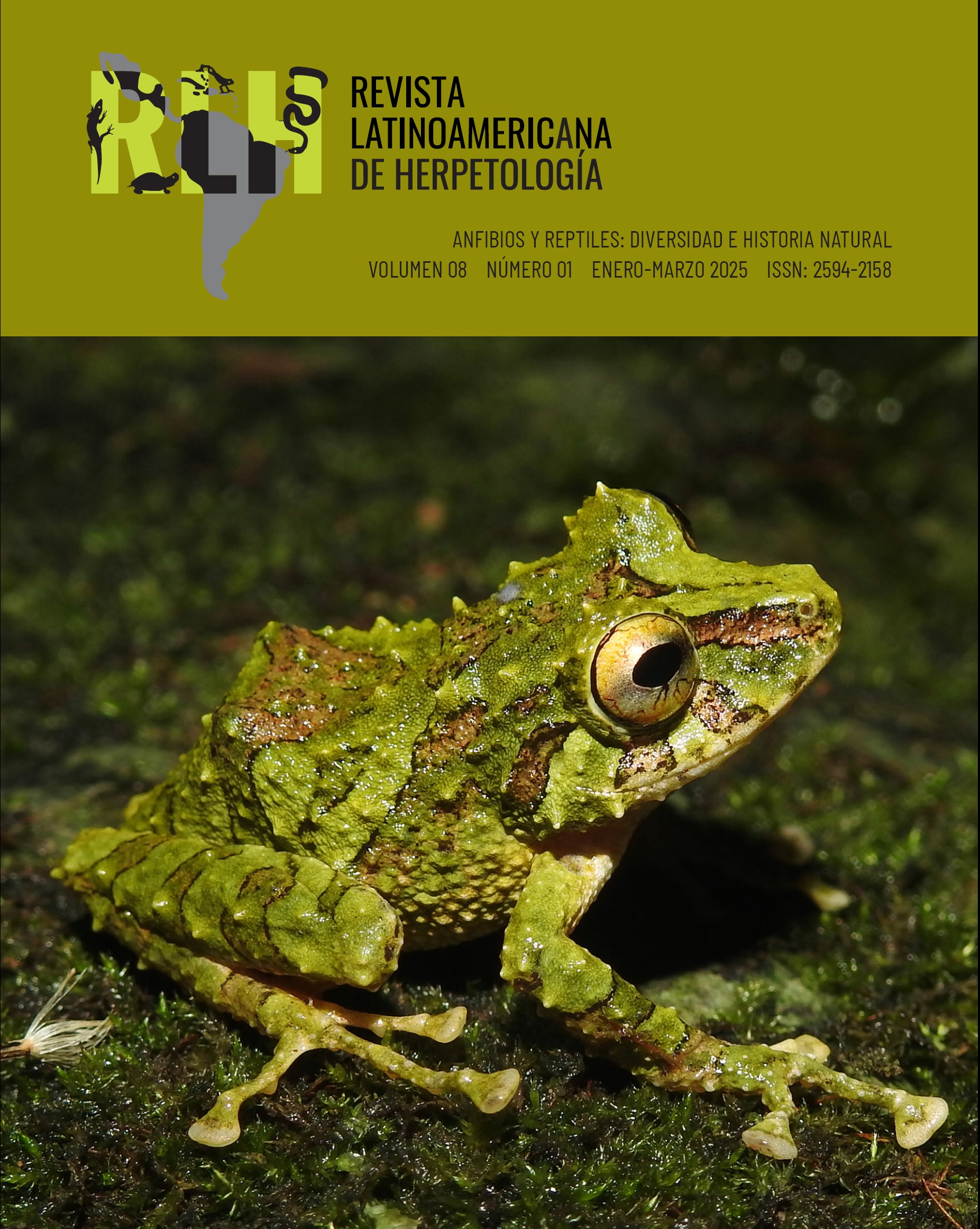FIRST ASSESSMENT OF THE HERPETOFAUNA OF MUTATÁ, URABÁ SUBREGION, COLOMBIA: A POST-CONFLICT DIVERSITY STUDY
DOI:
https://doi.org/10.22201/fc.25942158e.2025.1.1143Keywords:
Colombian armed conflict, species accumulation curve, Amphibians, Chocó-Darién, reptilesAbstract
The Urabá subregion in northwest Colombia boasts exceptional biological diversity, primarily attributable to its location within the Chocó-Darién ecoregion. However, efforts to characterize this diversity have been hindered by the Colombian armed conflict, which heavily impacted the region. With the signing of peace accords in 2016, improved security has increased agroindustry and human settlements, exacerbating forest fragmentation. This promoted accessibility underscores the urgency of characterizing the composition of the communities in order to subsequently generate conservation policites. As a first step to achieve this goal, our study aimed to identify herpetofauna species in forest fragments in the municipality of Mutatá, Urabá. Here, we report 24 amphibian and 30 reptile species across a sampling effort of 345 person-hours conducted at that site. Despite our efforts, the species accumulation curve indicated that further sampling is necessary to assess species richness more accurately. Urgent environmental action is imperative for conserving Urabá’s herpetofauna, particularly in post-conflict regions experiencing rapid shifts in land use. Agility in conservation efforts is crucial to mitigate further biodiversity loss, especially in these vulnerable areas.
References
Acuña-Vargas, J. 2016. Anfibios y reptiles asociados a cinco coberturas de la tierra, municipio de Dibulla, La Guajira, Colombia. Acta Zoológica Mexicana 32:133-146.
Alcaldía de Mutatá – Antioquia. 2012. Nuestro Municipio. https://www.mutata-antioquia.gov.co/ [Accessed August 2024]
Armenteras, D., J.M. Espelta, N. Rodríguez & J. Retana. 2017. Deforestation dynamics and drivers in different forest types in Latin America: Three decades of studies (1980-2010). Global Environmental Change 46:139-147.
Brumberg, H., S. Furey, M.G. Bouffard, M.J. Mata Quirós, H. Murayama, S. Neyestani, E. Pauline, A. Whitworth & M. Madden. 2024. Increasing forest cover and connectivity both inside and outside of Protected Areas in southwestern Costa Rica. Remote Sens 16: 1088.
Casas-Herrera, L.F., D.M. Gonzáles-Flórez, B. Segura, R.A. Mosquera & E. Álvarez-Dávila. 2018. Diversidad y estructura de bosques contrastantes en la región del Chocó-Darién, Colombia. Revista de Investigación Agraria y Ambiental 9:17-27.
Chadid, M.A., L.M. Dávalos, J. Molina & D. Armenteras. 2015. A Bayesian spatial model highlights distinct dynamics in deforestation from coca and pastures in an Andean biodiversity hotspot. Forests 6:3828-3846.
Chao, A. & L. Joust. 2012. Coverage-based rarefaction and extrapolation: standardizing samples by completeness rather than size. Ecology 93:2533-2547.
Clerici, N., D. Armenteras, P. Kareiva, R. Botero, J.P. Ramírez-Delgado, G. Forero-Medina, J. Ochoa, C. Pedraza, L. Schneider, C. Lora, C. Gómez, M. Linares, C. Hirashiki & D. Biggs. 2020. Deforestation in Colombian protected areas increased during post-conflict periods. Scientific Reports 10:4971.
Departamento Administrativo Nacional de Estadística (DANE). 2018. Censo Nacional de Población y Vivienda. https://www.dane.gov.co/index.php/estadisticas-por-tema/demografia-y-poblacion/censo-nacional-de-poblacion-y-vivenda-2018 [Accessed August, 2024]
Doan, T.M. 2003. Which methods are most effective for surveying rain forest herpetofauna? Journal of Herpetology 37:72-81.
Duellman, W.E. 1999. Patterns of Distribution of Amphibians: A Global Perspective. The Johns Hopkins University Press, Baltimore, Maryland, USA.
Hanski, I. 2011. Habitat Loss, the Dynamics of Biodiversity, and a Perspective on Conservation. Ambio 40:248-255.
Heyer, W.R., M.A. Donnelly, R.W. McDiarmird, L.A.C. Hayek & M.S. Foster. 1994. Measuring and Monitoring Biological Diversity. Standard Methods for Amphibians. Smithsonian Institution Press, Washington D.C., USA.
Hsieh, T.C., K.H. Ma & A. Chao. 2016. iNEXT: an R package for rarefaction and extrapolation of species diversity (Hill numbers). Methods in Ecology and Evolution 7:1451-1456.
Instituto de Estudios Ambientales (IDEAM). 2018. Mapa de Ecosistemas generales de Colombia. http://www.ideam.gov.co/web/ecosistemas [Accessed April 2021]
Kattan, G.H., P. Franco, V. Rojas & G. Morales. 2004. Biological diversification in a complex region: A spatial analysis of faunistic diversity and biogeography of the Andes of Colombia. Journal of Biogeography 31:1829-1839.
Kehoe, L., T. Kuemmerle, C. Meyer, C. Levers, T. Václavík & H. Kreft. 2015. Global patterns of agricultural land-use intensity and vertebrate diversity. Diversity and distributions 21:1308-1318.
Laurance, W.F., J.L.C. Camargo, P.M. Fearnside, T.E. Lovejoy, G.B. Williamson, R.C.G. Mesquita, C.F.G. Meyer, P.E.D. Bobrowiec & S.G.W. Laurance. 2018. An Amazonian rainforest and its fragments as a laboratory of global change. Biological Reviews 93:223-247.
Lynch, J.D., P.M. Ruiz-Carranza & M.C. Ardila-Robayo. 1997. Biogeographic patterns of Colombian frogs and toads. Revista de la Academia Colombiana de Ciencias Exactas, Fisicas y Naturales 21:237-248.
Myers, N., R.A. Mittermeier, C.G. Mittermeier, G.A.B. Da Fonseca & J. Kent. 2000. Biodiversity hotspots for conservation priorities. Nature 403:853-858.
Negret, P.J., L. Sonter, J.E.M. Watson, H.P. Possingham, K.R. Jones, C. Suárez, J.M. Ochoa-Quintero & M. Maron. 2019. Emerging evidence that armed conflict and coca cultivation influence deforestation patterns. Biological Conservation 239:108176.
Organización para las Naciones Unidas para la Alimentación y la Agricultura (FAO) & Gobernación de Antioquia. 2018. Plan integral de cambio climático de Antioquia. https://colaboracion.dnp.gov.co/CDT/Ambiente/PNACC/PIGCCT%20Antioquia.pdf [Accessed March 2024]
Ortiz-Yusty, C., J. Daza, V. Páez & B. Bock. 2015. The collection of the Herpetological Museum of the University of Antioquia (northwestern Colombia). Biodiversity Data Journal 3:e1325.
R Development Core Team. 2021. R: A language and environment for statistical computing. R Foundation for Statistical Computing, Vienna, Austria. http://www.R-project.org [Accessed August 2024]
Rivas, G.A., O.M. Lasso-Alcalá, D. Rodríguez-Olarte, M.D. Freitas, J.C. Murphy, C. Pizzigalli, J.C. Weber, L. Verteuil & M.J. Jowers. 2021. Biogeographical patterns of amphibians and reptiles in the northernmost coastal montane complex of South America. PLoS ONE 16:e0246829.
Sánchez-Cuervo, A.M. & T.M. Aide. 2013. Consequences of the armed conflict, forced human displacement, and land abandonment on forest cover change in Colombia: a multi-scaled analysis. Ecosystems 16:1052-1070.
Sistema de Información sobre Biodiversidad de Colombia (SiB Colombia). 2020. Biodiversidad en Cifras: Número de especies de anfibios y reptiles registrados en el SiB Colombia. https://cifras.biodiversidad.co/ [Accessed August 2024]
Suárez, V. & M. Herrera. 2021. Conflicto armado y biodiversidad: una mirada desde la ciudadanía cultural y la educación. Revista Educación y Ciudad 40:165-177.
Downloads
Published
How to Cite
Issue
Section
License
Copyright (c) 2025 Revista Latinoamericana de Herpetología

This work is licensed under a Creative Commons Attribution-NonCommercial-ShareAlike 4.0 International License.







